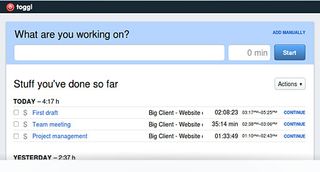I'd like to follow-up on a discussion that Dave started earlier this month (1, 2) on the importance of finding and consistently following a system. One of the tools he suggested using as part of his quest to stay on track was a web-based time tracking tool called Toggl. 
There is a story around this tool that I think is worth sharing...
Toggl was first brought to my attention by another Tidemark partner as a way of tracking the contributions that were being made on various projects. In essence, it is a web-based software application that asks one simple question:
“What are you working on?”
The user types a simple task description (for example: Preparing a WorkPuzzle blog) and then presses a “start” button. At this point, a timer starts ticking away and documents the time the user is dedicating to this task.
Since Tidemark develops recruiting software, I appreciate an elegant software design. On this front, Toggl has some great characteristics—simple to use, works well on any browser/computer platform, has both mobile and desktop applications that integrate with its core web-based environment, etc... And perhaps most importantly, the user interface design is well done—simple and easy to use.
While these characteristics are noteworthy, they are not what makes Toggl such a useful tool. Like most successful software businesses, Toggl helps solve a simple problem:
The fact is...most people are disengaged and waste a lot of time at work.
This business reality has been well-documented over the last decade and has probably been going on for many years before that. Kyle Lagunas, an HR Market Analyst for the popular blog, Software Advice, recently wrote a very insightful article on Engagement, that highlights recent Towers Watson research revealing that more than 60% of the U.S. workforce is not fully engaged in their work. He also cites Gallup research, estimating that this lack of engagement costs businesses in the United States more than $300 billion in lost productivity each year.
While I’ve read and known about this problem for years, I’ve never considered myself part of this “disengaged” group. I’ve always prided myself in tightly scheduling events, creating detailed tasks list, and seeking out accountability.
I work hard and stay focused.
At least I thought I did...until I started using Toggl.
Toggl has opened my eyes to a new reality. It has forced me to reach a new level of self-awareness that has been (initially) disheartening. I'm find myself asking these types of questions quite frequently:
“How could that task take so long?”
“Did I really spend two hours on email yesterday? I don’t seem to have accomplished much with those dialogs.”
“I’ve started this task four times and I’m constantly feeling distracted. What is it about this task that I don’t like doing?”
“Why is there 15 minutes of downtime between tasks (you can’t push the start button until you start the next task)? Could that downtime be used for something that renews my mind and spirit?”
In essence, Toggl has given me the ability to look backwards—across my day, across my week, and eventually across my year. While I’ve always been pretty good at putting together a plan, I was surprised to learn how poor I am at executing that plan.
So, thank you Toggl, for creating a great tool. If you’d like to try Toggl for yourself, check out their take a tour page. It is a free app for personal use and not very expensive to use with a team.
 Editor's Note: This article was written by Ben Hess. Ben is the Founding Partner and Managing Director of Tidemark, Inc. and a regular contributor to WorkPuzzle. Comments or questions are welcome. If you're an email subscriber, reply to this WorkPuzzle email. If you read the blog directly from the web, you can click the "comments" link below.
Editor's Note: This article was written by Ben Hess. Ben is the Founding Partner and Managing Director of Tidemark, Inc. and a regular contributor to WorkPuzzle. Comments or questions are welcome. If you're an email subscriber, reply to this WorkPuzzle email. If you read the blog directly from the web, you can click the "comments" link below.




Comments